Before there was a Seward Park on Essex Street in the Lower East Side of Manhattan, there was a square block of old wooden houses and crumbling brick tenements where hundreds of immigrants and alley cats made their home.
There once was a woman named Rosalie Goodman who lived in a dilapidated frame tenement house on the Lower East Side. She had so many cats – about 80 – there was no place for them to hide.
No, this is not a Mother Goose nursery rhyme. It’s a true story about a proverbial crazy cat lady named Rosalie Goodman and her home for down-and-out cats in New York’s Lower East Side.

Rosalie Goodman was a cat hoarder, or what we’d call a crazy cat lady. For almost a decade, she offered food and shelter for all the abused, abandoned, and injured felines that lived in the neighborhood bordered by Orchard, Hester, and Clinton streets and East Broadway. The children in the neighborhood called her Catty Goodman.
Rosalie Goodman (nee Rose Waare), was born in the Kingdom of Prussia in 1836, give or take a few years. She and her husband, Henry, a cigar maker (spelled “segar” on the 1870 Census report), came to America in the late 1850s and had four children: Elizabeth, Regina, Hilde, and Oscar. In 1870, the family was residing in an apartment at 175 Madison Street (near where the Manhattan Bridge is today).
Shortly after Henry’s death in 1871, Rosalie purchased the 17th-century house at 170 Division Street from Moses Bonner (Moses operated a cigar store there, so perhaps Henry Goodman had worked with him.) In his book, “New York by Sunlight and Gaslight: A Work Descriptive of the Great American Metropolis,” published in 1882, James Dabney McCabe calls this house “one of the greatest curiosities in New York.”

In the winter of 1875, a reporter from the New York Sun paid Rosalie Goodman a visit to see if rumors of this crazy cat woman were true. Upon his arrival, he saw dozens of cats hanging out in the nearby alleys, and on the eaves and window sills of her ramshackle home. In his front-page story, which was picked up by several newspapers in New York and other states, he paints a very vivid picture of the house where Rosalie and her feline boarders lived:
“The house was a three-story wooden building, gambrel-roofed and withered with age, and dates back to the Dutch period of the city. The sides and roof have collapsed with the pressure of time, and the clapboards and shingles, mossed and blackened, hang in tatters from the decaying beams and rafters. Inside, the oaken stairs and hall floors are worn into hollows from the use of former generations, and the rooms are low-ceilinged, narrow, and dusty, lighted by high, small-paned windows, and still provided with wide, open, old-fashioned fireplaces.”
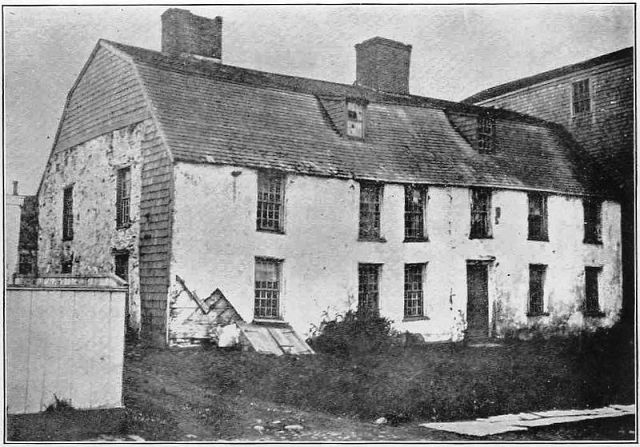
Outside, there was a courtyard about 15 feet deep, which was enclosed by a 10-foot fence. Scattered throughout the yard on that day in February 1875 were dozens of cats dining on soup and milk contained in white and yellow earthenware dishes. The reporter noted:
“The yard in the rear is a special playground of the museum. It is spacious, dirty and abounding in sly nooks that are just the thing for cats. At the back are a half-dozen patched wooden buildings similar to the one inhabited by Mrs. Goodman, each with an opening upon the enclosure.”
A Brief History of 170 Division Street
Before I continue this cat story, I believe a brief history of Rosalie Goodman’s home is in order.
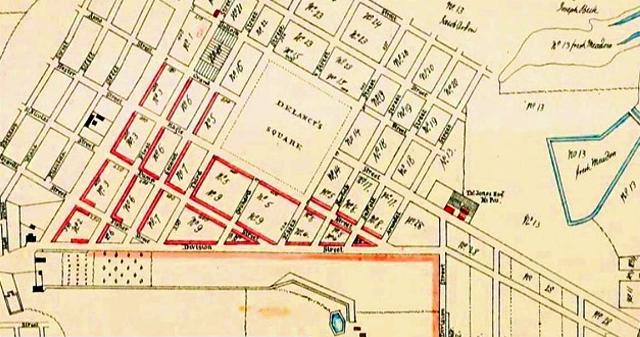
In the 1700s, when the house at 170 Division Street was constructed, the street marked the dividing line between the large farms of Hendrick Rutgers and James Delancey. Several old maps show Division and surrounding streets, but the earliest public record I could find for #170 was an ad promoting a public auction for the 22 x 82 foot lot at the Tontine Coffee House on August 24, 1825. Twenty years later, in 1845, the address was listed in the newspapers again, this time as the polling place for the Fourth District of the Tenth Ward.
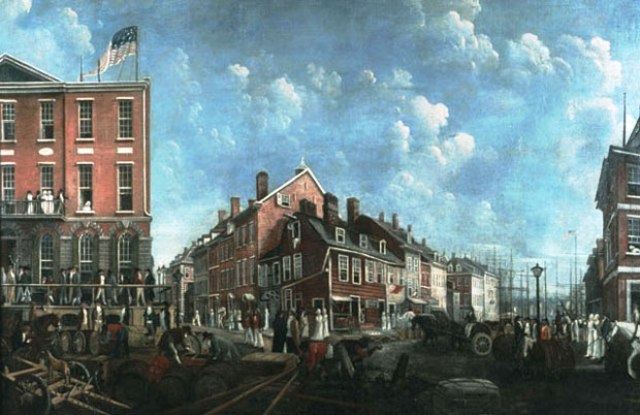
By 1867, Frederick Jochen owned the building and operated his paint store there (paints were mixed in the cellar of the building). There was a fire in the building that year, reportedly caused by some turpentine that had ignited in the cellar. Frederick and two other men were injured in the fire.
Moses Bonner was the owner of record in 1870. He operated a cigar store and rented one of the rooms to 20-year-old Isaac Busch. On the morning of May 7, 1870, Busch was introduced to 19-year-old Rachel Isaacs. The two were married by Justice Ledwith four hours later. The next day, Isaac left Rachel and moved to Brooklyn, but she stayed on in his apartment for some time at 170 Division Street.
By 1875, Louis Jacobi and Julius Moll, under the firm name of L. Jacobi & Co., were conducting a cigar manufacturing business at 170 Division Street. On May 6, they were indicted in the U.S. Circuit Court on the charge of affixing counterfeit Custom-house import stamps on boxes of domestic cigars. Judge Blatchford released the men, noting that it was their first offense and they had not intended to break the law.
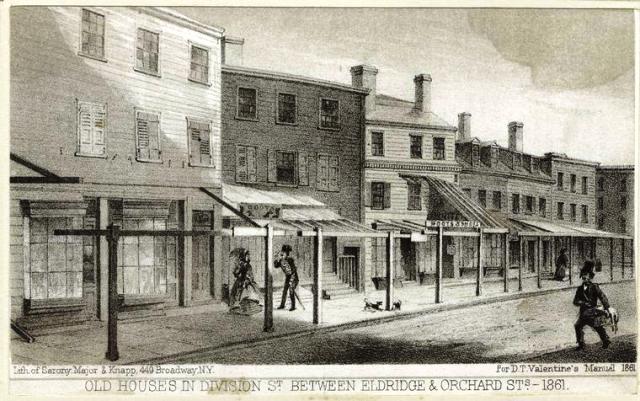
Rosalia’s Home for Hard-Luck Cats
During the 1870s, Rosalie Goodman occupied two small rooms in the rundown building. In a narrow room on the second floor, she made a home for her and the children; the room was also used as an indoor playroom for the cats. A similar sized room on the third floor served as a bedroom for those contented cats that preferred sleeping to prowling along the gambrel rooftops at night.
By renting rooms to tenants, Rosalie was able to make a living and provide for her family — human and feline. Some of her tenants included the cigar dealers on the basement level, an Irish family on the first floor, and a German man in a room on the second floor.
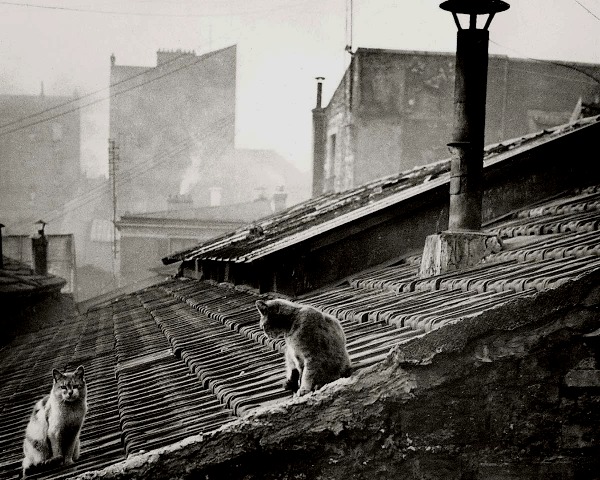
On the day The Sun reporter was visiting, there were several young men seated around a table in a dusky basement room playing a betting game called “huff and gruff.” When asked if the tenants got along with the cats, one man said, “If any of her tenants interferes with the rights of her cats, or abuse them, he may expect to leave his room at the earliest date.”
The outside of Rosalie’s house was reportedly far more inviting than the inside, where the Sun reporter saw rickety stairs, bare walls, dirty ceilings, and sawdust-covered hallways lined with tin water bowls. He evokes all the senses with these details:
“As the visitor clambers up the dark, cobwebbed staircases, evidence of cats are perceptible on every hand; cats yellow, cats black, golden and dingy; cats tawny, white, and dubious; cats ringtailed, dovetailed, and notailed; cats with eyes, without eyes, earless, and cats of every description skulk in the black nooks or rush out and disappear in sudden panic. And all the time, from sunrise to sunrise, an aromatic and voluminous cloud of feline exhalation is rafted down the stairs into the street.”
A Kitten Named Tiger

Before Rosalie Goodman took in her very first feline boarder, she was actually afraid of cats. Then one day she came upon “a wee little kitten, a homeless street Arab which she nursed and Christianized” and named Tiger. Before long, Tiger had told all his friends on Essex Street about the nice lady and good food at 170 Division Street.
At first, Rosalie did not intend to provide a permanent refuse for the Lower East Side cats. But then one day someone stole Tiger and hid him in a basement, where he starved to death. She told the reporter (who translated her broken English into proper speech):
“I found nothing but his bones, and I buried him, and then I made up my mind that I’d take care of all the cats I could when people turned them out in the cold to starve. It’s only people without sense or heart that would turn a helpless animal out in the cold. There ought to be some asylum for such abandoned animals in this country, as there is in England, but there is none, and somebody must look out for them. I don’t love the cats yet, but I pity them, and I think when I’m dead they’ll have no one to take care of them.”
After Rosalie Goodman’s story was published in The Sun, other news reporters stopped by to get their own stories. In August 1877, a reporter from The Daily Tribune paid a visit and found her surrounded by about 50 cats while stirring a compound in a pot on the stove. Rosalie said she bought the best cakes, sausages, and beefsteaks she could find along the Bowery, and spent about $1.50 a day to feed all her feline charges. As she spoke, she took the large iron kettle from the stove and poured a warm boiled dinner upon a piece of oilcloth. “The cats ate daintily, as though used to a good living.”
By the summer of 1878, Rosalie Goodman was apparently fed up with the nosy reporters. On July 18, 1878, a reporter from The Daily Graphic got booted out when he tried to make his way into her room:
“Now, you get out!” Rosalie shouted at the reporter. “I don’t told you but once. I have no more newspaper mens make some moneys out of me. My lawyer say to me no reporter have any right to come in my house, and if so I shall shoot him or push him down stairs or take my broomstick.”
Not only did she have the right to show the reporter to the door, but she also had a right to keep the cats. Although the neighbors tried to put an end to the crazy cat house, they couldn’t win. One time they called the Board of Health, but the officers, after inspecting the premises, said that she had not violated any law by helping the suffering. With the law on Rosalie’s side, the neighbors resorted to showering gravel from the rooftops on the poor cats in the courtyard.
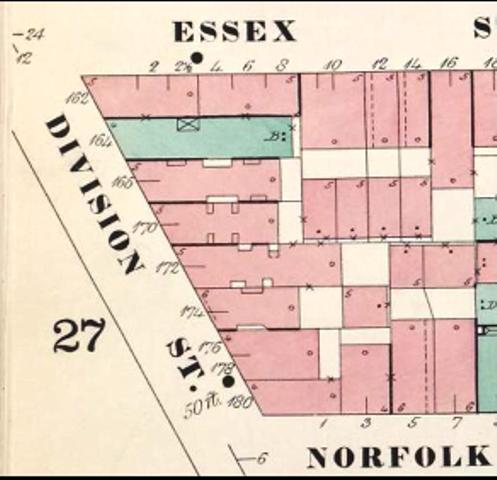
The End Comes to 170 Division Street
Just two years after the last reporter’s visit to Rosalie’s cat house in 1878, she moved into a new apartment on 19th Street with her four children and her mother, Dore Waare. The old Dutch house was torn down around 1884, when plans were submitted to construct a five-story double brick tenement building in its place at the estimated cost of $16,000. An ad in the New York Daily Tribune on November 1, 1885, listed the 28.9 x 70 foot tenement with stores (12 families per floor) for sale. There was no mention of 80 cats being part of the deal.
It was a destructive fire on April 29, 1897, that led to the final demise of 170 Division Street. The fire started in the bottom of an airshaft shared with 166 Division Street, which was used for storage by the housekeeper, Philip Babinsky. About 15 families were displaced by the early-morning blaze, many of whom had to be rescued from the upper floors by the firemen of No. 6 Truck.
Two months later, the city took title to building, paying the building’s owners, Samuel Wine and Lena Levy, $31,500 for the burnt-out tenement. The rest, they say, is history, specifically, the history of Seward Park.
The Birth of Seward Park
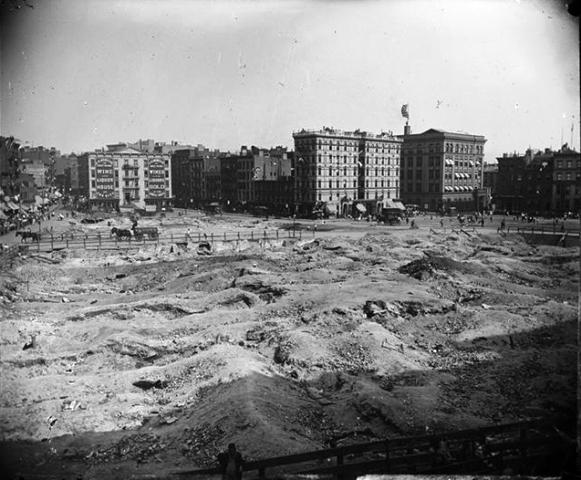
In 1887, New York City Mayor Abram S. Hewitt passed a law giving the city rights to purchase land for small parks. A few years later, in February 1893, the officers of the Tenth Ward Social Reform Club proposed that one of these parks be placed in their ward to benefit the poor people. Their idea was to buy all the rear tenement buildings –“the worst feature of the tenement house evil”–and then convert the heart of each block into a series of small parks that would be connected by gateways.

Although this plan never came to fruition, in 1897 the city began taking steps to create a new public park for the Lower East Side. The first step, which would eventually cost $1.8 million, was to condemn and demolish rows of decaying tenements on the blocks from Canal Street and East Broadway to Grand Street between Essex and Jefferson Streets. The second step was to level and fence in the site.
Due to lack of funds, the next major step didn’t come for seven more years. The site remained largely unimproved, and, according to Jacob Riis, author of “How the Other Half Lives,” the Tammany politicians simply allowed fish peddlers to put up shanties in the fenced-in land (particularly along Hester Street). Many residents wrote letters to the newspapers complaining that the city had not done anything to create an actual park.
Right around this time, a group of social reformers led by Lillian D. Wald and Charles B. Stover founded the Outdoor Recreation League. The ORL stepped up to the plate for the community by providing playground and gymnasium equipment, personnel, and other support until the city took over the administration and re-opened Seward Park in October 1903.
For more information about the park and its history, check out The Friends of Seward Park website.

Stray Cat Depositories
Although Seward Park was a blessing for the humans of the Lower East Side, it was not such a good thing for all those cats that were displaced when it was constructed.
According to an article about the neighborhood’s prolific stray cat population in the New York Evening Post on June 16, 1920, residents were invited to drop off stray cats at the cat “dumping station” at Seward Park. The Society for the Prevention of Cruelty to Animals would then take the cats away to euthanize them by means of poison gas in the “death “house” (so much for preventing cruelty). The article stated that 50 to 100 cats were rounded up each day from the “park depositories.”
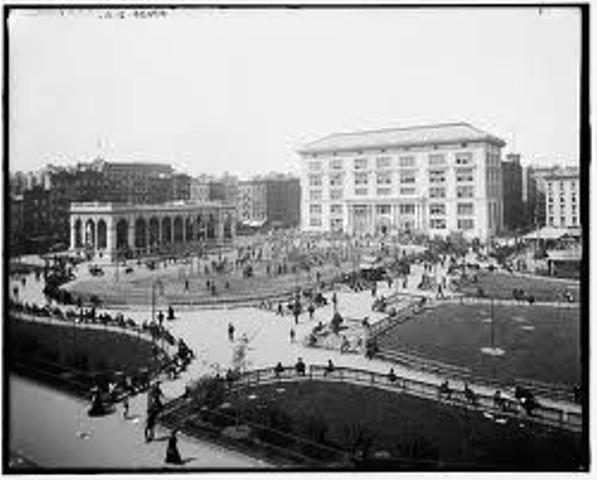
Sadly, another article in the Evening Post (June 6, 1925) titled “Cat Collecting Fans in Warm Glory Today,” reported that some people actually made a hobby out of collecting stray cats and bringing them to the SPCA. I wonder what Rosalie Goodman would have had to say about this atrocity.



[…] from THE FRENCH HATCHING CAT […]